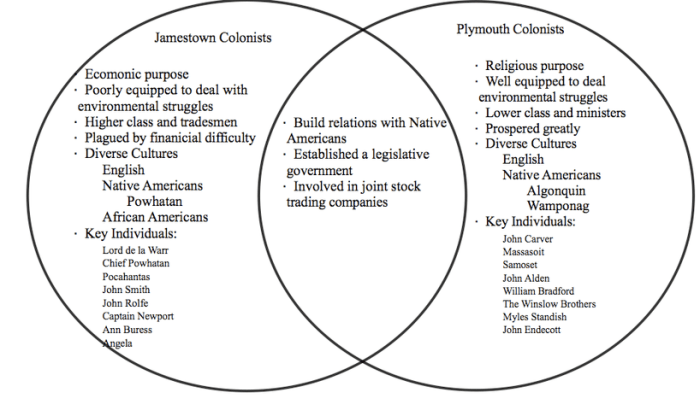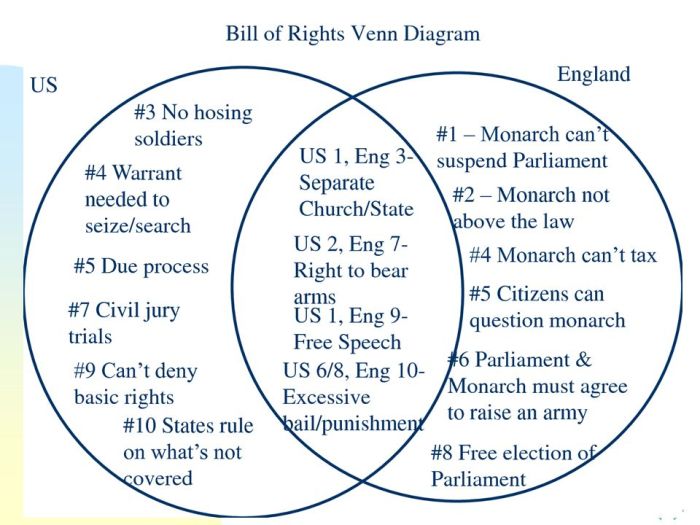The Jamestown and Plymouth Venn diagram serves as a visual representation of the similarities and differences between these two pivotal settlements in American history. By examining their shared experiences and contrasting aspects, we gain a deeper understanding of the challenges, motivations, and legacies of these early colonial endeavors.
Established in 1607 and 1620 respectively, Jamestown and Plymouth played significant roles in shaping the development of the United States. Both settlements faced formidable challenges, including harsh environmental conditions, conflicts with Native American tribes, and economic hardships. However, they also shared commonalities such as their reliance on agriculture, the establishment of representative governments, and their role as gateways to the New World.
Historical Background

Jamestown and Plymouth hold significant positions in the annals of American history as the earliest successful English settlements in North America. Jamestown, established in 1607, served as the capital of the Virginia Colony, while Plymouth, founded in 1620, became the hub of the Plymouth Colony.
The motivations and goals of the settlers in both settlements were multifaceted. Jamestown was primarily driven by economic interests, with the Virginia Company seeking to establish a profitable colony based on cash crops like tobacco. Plymouth, on the other hand, was founded by a group of religious dissenters, known as the Pilgrims, seeking to establish a society based on their Puritan beliefs.
Similarities between Jamestown and Plymouth
Despite their contrasting motivations, Jamestown and Plymouth shared several common characteristics and experiences.
- Both settlements faced significant challenges, including harsh weather conditions, disease, and conflicts with Native American tribes.
- Economically, both colonies relied heavily on agriculture, with tobacco and corn serving as primary crops in Jamestown and Plymouth, respectively.
- Socially, both settlements established hierarchical structures, with the leaders of the Virginia Company and the Puritan elders holding considerable power.
Differences between Jamestown and Plymouth
While they shared similarities, Jamestown and Plymouth also exhibited distinct differences.
- Geographically, Jamestown was situated on the marshy banks of the James River, while Plymouth was located on the rocky coast of Massachusetts.
- Environmentally, Jamestown faced a hot and humid climate with frequent hurricanes, while Plymouth experienced cold winters and rocky terrain.
- Politically, Jamestown was governed by a royal charter, while Plymouth operated under a self-governing covenant known as the Mayflower Compact.
Venn Diagram: Jamestown And Plymouth Venn Diagram

The following Venn diagram illustrates the similarities and differences between Jamestown and Plymouth:
Similarities:
- Established in early 17th century
- Faced challenges from weather, disease, and Native Americans
- Relied on agriculture
- Established hierarchical societies
Differences:
- Motivations: Jamestown – economic, Plymouth – religious
- Location: Jamestown – Virginia, Plymouth – Massachusetts
- Environment: Jamestown – hot, humid, Plymouth – cold, rocky
- Governance: Jamestown – royal charter, Plymouth – Mayflower Compact
Legacy and Impact

Jamestown and Plymouth played pivotal roles in shaping the development of the United States.
- Jamestown introduced English institutions and culture to North America, laying the foundation for the Virginia Colony and the eventual United States.
- Plymouth established a model of religious freedom and self-governance, influencing the development of American democracy and constitutionalism.
- Both settlements contributed to the growth and expansion of the American colonies, paving the way for the formation of a new nation.
Essential FAQs
What were the primary motivations for the establishment of Jamestown and Plymouth?
Jamestown was founded by the Virginia Company as a commercial venture seeking economic gain, while Plymouth was established by the Pilgrims as a refuge for religious dissenters.
How did the geographic locations of Jamestown and Plymouth influence their development?
Jamestown’s location on the James River provided access to trade and transportation, while Plymouth’s coastal location offered protection and opportunities for fishing and shipbuilding.
What were the key challenges faced by the settlers of Jamestown and Plymouth?
Both settlements struggled with disease, conflict with Native Americans, and economic hardships.